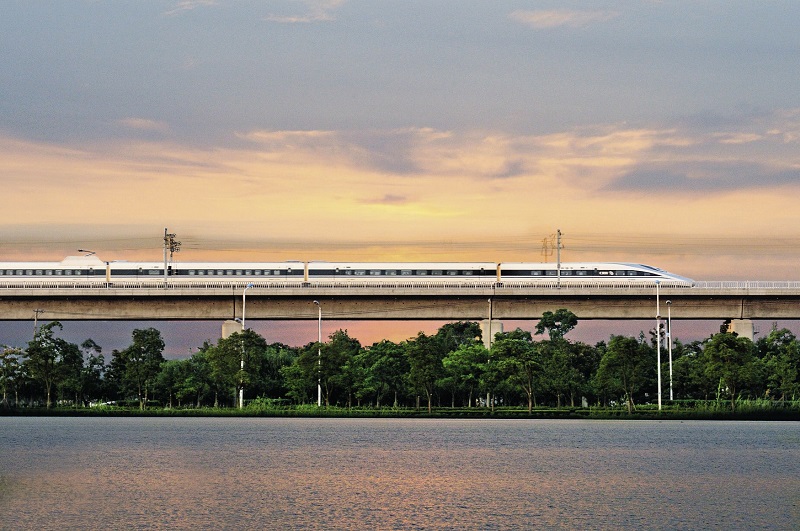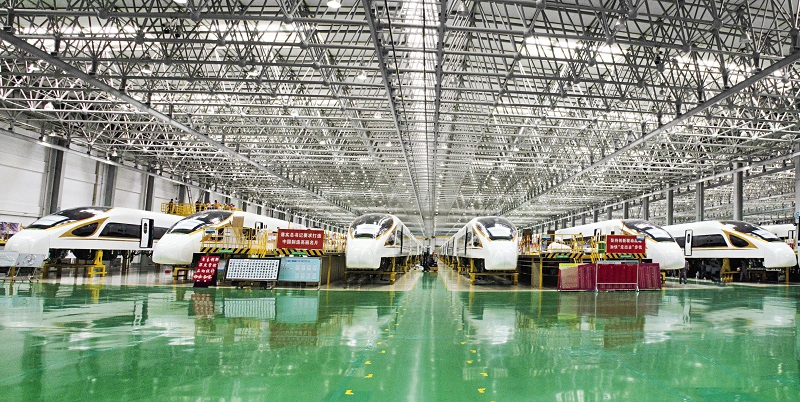With the first spike being hammered in on the Tangshan-Xugezhuang Railway, work began on laying China’s first railway tracks on June 9, 1881. Meanwhile, the country’s first steam locomotive, Loong, also known as Rocket of China, was being assembled in China’s first locomotive factory.
Later relocated to Tangshan, the factory was the predecessor of China Railway Rolling Stock Corporation Limited (CRRC). China later established railway rolling stock factories in cities of Harbin, Beijing, Taiyuan, and Qingdao. China’s locomotive industry has been constantly contributing to the development of the world’s rail transit industry through continuous product and technology innovation.

A CRH380A EMU can run at full speed on Beijing-Shanghai high-speed rail.
Legacy of More than a Century
Established in the 19th century, CRRC has established an entire series of rail transit products represented by Fuxing bullet trains in the 21st century. The products have served 109 countries and regions around the world.
The founding of the People’s Republic of China in 1949 gave its rail transit equipment manufacturing industry a rebirth. With a complete research and development (R&D) system and manufacturing system for rail transit equipment, CRRC has built the capacity for independently developing various products such as steam locomotives, diesel locomotives, electric locomotives, passenger trains, subway vehicles, and railway wagons, basically meeting China’s enormous rail transportation needs.
Since China’s reform and opening-up began, its rail transit equipment manufacturing industry has shown new vitality. It carried out internal combustion and electrification transformation, developed different types of locomotives, and passenger and freight trains, promoted the upgrading of locomotives and vehicles, and provided equipment support for the six major speed-ups of China’s railways.
Since 2004, the industry has made further innovation on the basis of absorbing overseas technical advances. CRRC started to produce CRH2, CRH3, CRH5, and other Hexie EMUs (Electric Multiple Units) through cooperation with Alstom of France, Siemens of Germany, and Kawasaki Heavy Industries of Japan. It also developed the CRH380 EMUs. On December 3, 2010, the CRH380AL hit a maximum speed of 486.1 kilometers per hour during its trial service on Beijing-Shanghai high-speed rail, which broke the world operational speed record at the time.
Since 2012, President Xi Jinping has inspected CRRC three times and encouraged its employees to continue to lead the way. With his request in mind, CRRC promoted technological innovation, and successfully developed EMUs with Chinese-developed standards. The Fuxing EMUs are now operating at a speed of 350 kilometers per hour on Beijing-Shanghai high-speed railway and other lines, making China the country with the highest railway operating speed in the world.
Today nearly 4,000 high-speed trains are running across the vast expanse of China, an epitome of the tremendous progress the country has made in the rail industry.
Independent Innovation
China has made world-renowned achievements in high-speed rail development. By the end of 2020, the operating mileage of its high-speed rail reached 37,900 kilometers, accounting for 69 percent of the world’s total.
The development of China’s high-speed rail is based on innovation. On the basis of mastering the nine key technologies and 10 supporting technologies of the EMU and following Chinese standards, the Fuxing EMUs have been developed with completely independent intellectual property rights and the capability of hitting speeds up to 350 kilometers per hour. Among the 254 important standards adopted by EMUs, Chinese standards account for 84 percent. In terms of subway trains, all 30 key parts and components adopt Chinese standards.
CRRC has developed EMU products with entirely independent intellectual property rights. They include Fuxing EMUs at speeds of 160 to 350 kilometers per hour, a high-speed maglev train capable of hitting an astounding speed of 600 kilometers per hour, variable gauge cross-border interconnection EMUs with a speed of 400 kilometers per hour, freight trains with a speed of 350 kilometers per hour, and the first Chinese standard subway trains. Intelligent EMUs, dual-source EMUs, and other electric locomotives have been put into operation one after another. The technologies used in rail transportation equipment such as high-power locomotives, heavy-duty railway wagons, freight trains, and urban rail vehicles are all leading in the world.
During the process of innovation, CRRC has also formed a technological innovation system that covers product development, simulation calculation, test verification, and application of research results. During the 13th Five-Year Plan period (2016-2020), CRRC issued a total of 48 international standards, 143 national standards, and 243 industry standards. It owns 23,486 patents in force, including 9,974 patents for inventions. In 2020, CRRC ranked 349th on the Fortune Global 500 list.

Several EMUs at a manufacturing factory.
New Goods
Moving into the future, the CRRC will make new breakthroughs in technological innovation, and focus on the following aspects.
First, it will work following China’s carbon peak and neutrality goals by promoting smart transformation and digitalization. For the construction of transportation networks, production of advanced and safe transportation equipment, convenient passenger transportation, and multimodal cargo transportation, CRRC will actively promote the “technology plus” and “product plus” models, and make systematic planning for key products and solutions.
Second, it will focus on system-based solutions and major product R&D. In the fields of high-speed trains, high-speed maglev lines, smart transportation, and Sichuan-Tibet railway equipment, CRRC will establish a technological system covering core technologies, key equipment, integrated applications, and standard specifications.
Third, it will create an innovative ecology of the industrial manufacturing chain, adopt the “technology plus” model, and increase the efficiency and aggregation of industrial chain resources. Giving full play to its core advantages in rail transit equipment manufacturing, CRRC will strengthen open cooperation in the industrial chain, integrate the industrial chain with the innovation chain, and strive to lead in the modern industrial chain on a global level.
Fourth, it will deepen reform to stimulate innovation and vitality. This includes optimizing the distribution of innovative resources, building a special zone for scientific and technological innovation, fostering a strong scientific and technological talent team, and strengthening the Party’s leadership of scientific and technological work. CRRC will fully respect and harness the creativity of its scientific and technological personnel, encourage them to become promoters and practitioners of innovation, and make innovation a conscious action.
Its cutting-edge technology as well as quality and reliable products have allowed CRRC to flourish and build its brand abroad. As of now, CRRC has provided services to 109 countries and regions with 83 branches set up in 26 countries and regions.